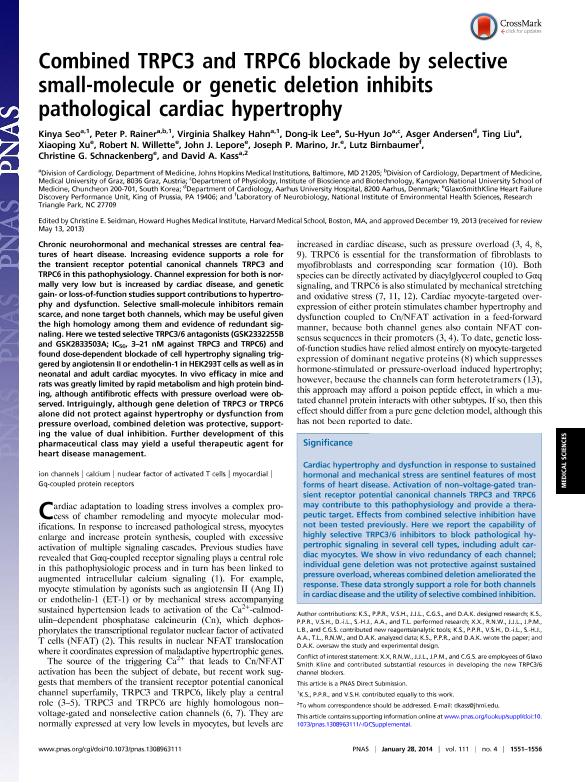Mostrar el registro sencillo del ítem
dc.contributor.author
Seo, Kinya
dc.contributor.author
Rainer, Peter P.
dc.contributor.author
Shalkey Hahn, Virginia
dc.contributor.author
Lee, Dong-ik
dc.contributor.author
Jo, Su-Hyun
dc.contributor.author
Andersen, Asger
dc.contributor.author
Liu, Ting
dc.contributor.author
Xu, Xiaoping
dc.contributor.author
Willette, Robert N.
dc.contributor.author
Lepore, John J.
dc.contributor.author
Marino, Joseph P.
dc.contributor.author
Birnbaumer, Lutz

dc.contributor.author
Schnackenberg, Christine G.
dc.contributor.author
Kass, David A.
dc.date.available
2020-03-06T16:27:27Z
dc.date.issued
2014-01-28
dc.identifier.citation
Seo, Kinya; Rainer, Peter P.; Shalkey Hahn, Virginia; Lee, Dong-ik; Jo, Su-Hyun; et al.; Combined TRPC3 and TRPC6 blockade by selective small-molecule or genetic deletion inhibits pathological cardiac hypertrophy; National Academy of Sciences; Proceedings of the National Academy of Sciences of The United States of America; 111; 4; 28-1-2014; 1551-1556
dc.identifier.issn
0027-8424
dc.identifier.uri
http://hdl.handle.net/11336/98932
dc.description.abstract
Chronic neurohormonal and mechanical stresses are central fea-tures of heart disease. Increasing evidence supports a role forthe transient receptor potential canonical channels TRPC3 andTRPC6 in this pathophysiology. Channel expression for both is nor-mally very low but is increased by cardiac disease, and geneticgain- or loss-of-function studies support contributions to hypertro-phy and dysfunction. Selective small-molecule inhibitors remainscarce, and none target both channels, which may be useful giventhe high homology among them and evidence of redundant sig-naling. Here we tested selective TRPC3/6 antagonists (GSK2332255Band GSK2833503A; IC50,3–21 nM against TRPC3 and TRPC6) andfound dose-dependent blockade of cell hypertrophy signaling trig-gered by angiotensin II or endothelin-1 in HEK293T cells as well as inneonatal and adult cardiac myocytes. In vivo efficacy in mice andrats was greatly limited by rapid metabolism and high protein bind-ing, although antifibrotic effects with pressure overload were ob-served. Intriguingly, although gene deletion of TRPC3 or TRPC6alone did not protect against hypertrophy or dysfunction frompressure overload, combined deletion was protective, support-ing the value of dual inhibition. Further development of thispharmaceutical class may yield a useful therapeutic agent forheart disease management.
dc.format
application/pdf
dc.language.iso
eng
dc.publisher
National Academy of Sciences

dc.rights
info:eu-repo/semantics/openAccess
dc.rights.uri
https://creativecommons.org/licenses/by-nc-sa/2.5/ar/
dc.subject
ION CHANNELS
dc.subject
CALCIUM
dc.subject
NUCLEAR FACTOR OF ACTIVATED
dc.subject
T CELLS
dc.subject.classification
Bioquímica y Biología Molecular

dc.subject.classification
Ciencias Biológicas

dc.subject.classification
CIENCIAS NATURALES Y EXACTAS

dc.title
Combined TRPC3 and TRPC6 blockade by selective small-molecule or genetic deletion inhibits pathological cardiac hypertrophy
dc.type
info:eu-repo/semantics/article
dc.type
info:ar-repo/semantics/artículo
dc.type
info:eu-repo/semantics/publishedVersion
dc.date.updated
2019-10-28T18:26:20Z
dc.identifier.eissn
1091-6490
dc.journal.volume
111
dc.journal.number
4
dc.journal.pagination
1551-1556
dc.journal.pais
Estados Unidos

dc.journal.ciudad
Washington
dc.description.fil
Fil: Seo, Kinya. Johns Hopkins Medical Institutions. Department of Medicine; Estados Unidos
dc.description.fil
Fil: Rainer, Peter P.. Johns Hopkins Medical Institutions. Department of Medicine; Estados Unidos. Medical University of Graz. Department of Medicine; Austria
dc.description.fil
Fil: Shalkey Hahn, Virginia. Johns Hopkins Medical Institutions. Department of Medicine; Estados Unidos
dc.description.fil
Fil: Lee, Dong-ik. Johns Hopkins Medical Institutions. Department of Medicine; Estados Unidos
dc.description.fil
Fil: Jo, Su-Hyun. Kangwon National University School of Medicine; Corea del Sur. Johns Hopkins Medical Institutions. Department of Medicine; Estados Unidos
dc.description.fil
Fil: Andersen, Asger. Aarhus University Hospital. Department of Cardiology; Dinamarca
dc.description.fil
Fil: Liu, Ting. Johns Hopkins Medical Institutions. Department of Medicine; Estados Unidos
dc.description.fil
Fil: Xu, Xiaoping. GlaxoSmithKline Heart Failure Discovery Performance Unit; Estados Unidos
dc.description.fil
Fil: Willette, Robert N.. GlaxoSmithKline Heart Failure Discovery Performance Unit; Estados Unidos
dc.description.fil
Fil: Lepore, John J.. GlaxoSmithKline Heart Failure Discovery Performance Unit; Estados Unidos
dc.description.fil
Fil: Marino, Joseph P.. GlaxoSmithKline Heart Failure Discovery Performance Unit; Estados Unidos
dc.description.fil
Fil: Birnbaumer, Lutz. ational Institute of Environmental Health Sciences; Estados Unidos. Consejo Nacional de Investigaciones Científicas y Técnicas. Oficina de Coordinación Administrativa Houssay. Instituto de Investigaciones Biomédicas. Universidad de Buenos Aires. Facultad de Medicina. Instituto de Investigaciones Biomédicas; Argentina
dc.description.fil
Fil: Schnackenberg, Christine G.. GlaxoSmithKline Heart Failure Discovery Performance Unit; Estados Unidos
dc.description.fil
Fil: Kass, David A.. Johns Hopkins Medical Institutions. Department of Medicine; Estados Unidos
dc.journal.title
Proceedings of the National Academy of Sciences of The United States of America

dc.relation.alternativeid
info:eu-repo/semantics/altIdentifier/url/http://www.pnas.org/content/111/4/1551
dc.relation.alternativeid
info:eu-repo/semantics/altIdentifier/doi/http://dx.doi.org/doi.org/10.1073/pnas.1308963111
Archivos asociados
